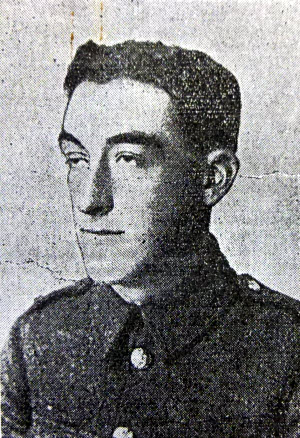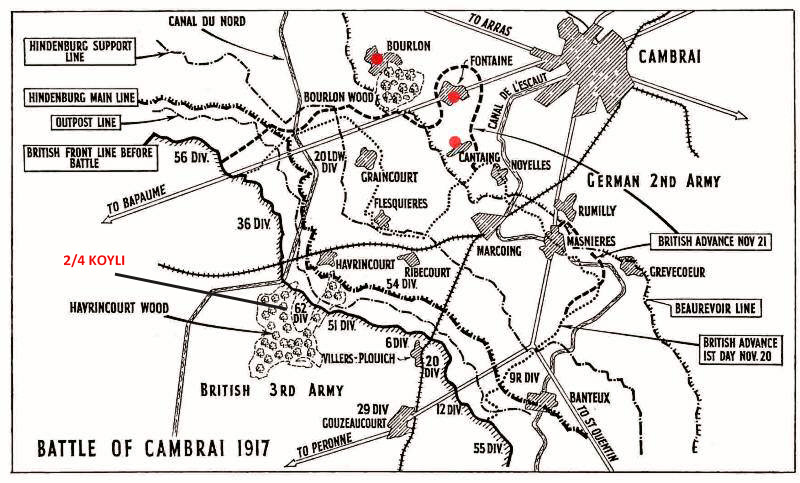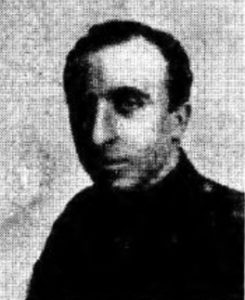
Fred Earnshaw was born in Netherton on the 3rd November 1895, the eldest child of six children born to Timber Yard Foreman, Henry Earnshaw and his wife Eliza (nee Lee) who married in Spring 1895.
In 1901 Fred, aged 5, was staying with his grandparents, William, a Timber Merchant and assistant overseer, and Martha who lived at Midgley. Fred’s parents were living nearby at Middlestown End with three of Fred’s siblings including one girl aged 2 months. In 1911 Fred, aged 15 and a scholar was living with his parents and five siblings at the seven-roomed house: The Laurels, Netherton.
Fred was 18 years of age when Great Britain declared war against Germany on the 4th August 1914. On the 11th February 1915, aged 19 years and 3 months, 5’ 3” tall and a draughtsman by trade, he enlisted at Wakefield for the duration of the war and joined the 10th Battalion, Lincolnshire Regiment. He served “at home” until he embarked for France on the 9th January 1916.
The 10th battalion Lincolnshire Regiment was often known as the “Grimsby Chums.” It was formed at Grimsby on the 9th September 1914 by the Mayor and Town coming under the command of the 101st Brigade, 34th Division in June 1915, before transferring to the 103rd Brigade in the same Division in February 1918.
The Chums embarked for France on January 4th 1916. Fred caught up with the main party a few days later. They reformed at Le Havre and set off for rest camp before deployment in the Armentiers sector. It was standard practice to give new units a taste of the trenches in quiet areas. The duty of introducing them to the trench system fell to the regular unit currently there, old soldier to new soldier. The chums were also part of an inspection by Kitchener himself during February. These early months were a prelude to a much greater event to take place in July.
Like most of the rest of the British Army, the Chums got wind of a “big push”. Their involvement in working parties increased, fetching supplies, gas and ammonal explosive up to the front lines. The Somme area had been chosen as the battleground for the push, and the softening up shelling of the enemy line began in earnest a week before zero hour. The Lincolns could hear the bombardment and could see the damage inflicted on the enemy trenches. They believed what they were told by the officers, that the enemy would not survive and that the attack would be over within hours.
The Battle of the Somme was to be the first use, en masse, of the New Kitchener Army and was designed to relieve pressure on Verdun where the French were locked in a fight to the death. Faith in the ability of the New Army was not high among the regular Staff Officers of the British Command. They did not believe an attack would be successful if it relied solely on an infantry attack. In order to help, a bombardment was which turned out to be one week long and up to that point the largest ever seen. The word was sent round that nothing would remain of the German front line at zero hour, 1st July, allowing the New Army to walk at a steady pace, in line, so chaos did not occur.
“The section of the line held by the Chums and their 101st Brigade comrades was at La Boiselle. Prior to attack, at 7.28 a.m., a large mine was exploded beneath the German line, the Chums were then to attack at 7.30 a.m. Unknown to the Battalion, the mine fell short of the German positions and during the 2 minute gap between the explosion and the “whistle” the enemy had the chance to set up their machine guns.
The Chums were drawn up with “A” Company on the right, “B” Company on the left and “C” Company, opposite the crater, in the centre. “D” Company was in reserve for phase two. They advanced in four straight lines with no hesitation. It was a matter of moments when the first men fell, as the German mortars and machine guns opened up. Officers and men alike dropped to the ground as if the move was planned in training, in fact they were killed or wounded. Only a few men reached the German trenches, bombing for all they were worth, but in too few numbers, they had to retreat.
By 9 a.m. “D” Company were sent to attack led by Major Vignoles, who was soon hit in the hand. Again, the attack broke up and the 10th Lincolns were left powerless to attack, laying in shell holes in No Man’s Land in the baking sun. All were waiting for nightfall to be able to crawl back to their own lines for treatment. Several attempts to attack were made with the remnants of the Battalion on the 2nd and 3rd July, but as the roll was called when they were finally withdrawn it read 15 Officers and 487 men (out of the battalion of about 1000 men ) killed, missing or wounded.” 1
A personal war diary 2 of a 10th Battalion, Lincolnshire Regiment soldier, Ernest Lister who was wounded but survived recollects:-
“At 6.30 a.m. Saturday morning every gun we had (for a frontage of 10 miles) opened a rapid fire, fairly making the earth shake. Each Battalion moved into position at 7.15 a.m., we blew up two mines under Fritz’s second and third lines (using 7 tons of Ammonal, a high explosive). It was just like an earthquake as each mine went up the whole earth trembled in fact rocked for two seconds.
At 7.30 a.m. our first line went over the top and then Fritz opened out with his machine guns from all quarters it seemed, not to mention a continual hail of shrapnel and coal boxes (coal boxes are shells when burst given off a big amount of black smoke which gives the appearance of coal fumes). The good old “Chums” or tenth Lincs as we like to be called were the first over in our division except for “D” Company which went over last to form a “Strong Point” in the German fourth line. Anyhow our turn came the order was passed down “Over the top lads” no one shrank back, but as one man climbed on the parapet. Zip zip zip then k-rupp, k-rupp bullets and shells all around but on we went, but we had not gone far before down went one man, then another and another.”

Private Fred Earnshaw, aged 20 years, son of Henry and Eliza Earnshaw, of Midgley, Wakefield, Yorks., was killed in action at Beaucourt Wood on the 1st July 1916 and is remembered on Pier and Face 1 C. at the Thiepval Memorial,3 Somme, France. The Thiepval Memorial can be found on the D73, next to the village of Thiepval, off the main Bapaume to Albert road (D929).
Shortly after Fred’s death an officer wrote: “He was held in high esteem in his platoon. He was a quiet and unassuming boy, who always did his work in a cheerful and winning manner. We miss him very much.” Fred Earnshaw was awarded the British and Victory medals for his service overseas in WW1.
On 1 July 1916, supported by a French attack to the south, thirteen divisions of Commonwealth forces launched an offensive on a line from north of Gommecourt to Maricourt. Despite a preliminary bombardment lasting seven days, the German defences were barely touched and the attack met unexpectedly fierce resistance. Losses were catastrophic and with only minimal advances on the southern flank, the initial attack was a failure. In the following weeks, huge resources of manpower and equipment were deployed in an attempt to exploit the modest successes of the first day. However, the German Army resisted tenaciously and repeated attacks and counter attacks meant a major battle for every village, copse and farmhouse gained. At the end of September, Thiepval was finally captured. The village had been an original objective of 1 July. Attacks north and east continued throughout October and into November in increasingly difficult weather conditions. The Battle of the Somme finally ended on 18 November with the onset of winter.
In the spring of 1917, the German forces fell back to their newly prepared defences, the Hindenburg Line, and there were no further significant engagements in the Somme sector until the Germans mounted their major offensive in March 1918.
The Thiepval Memorial, the Memorial to the Missing of the Somme, bears the names of more than 72,000 officers and men of the United Kingdom and South African forces who died in the Somme sector before 20 March 1918 and have no known grave. Over 90% of those commemorated died between July and November 1916. The memorial also serves as an Anglo-French Battle Memorial in recognition of the joint nature of the 1916 offensive and a small cemetery containing equal numbers of Commonwealth and French graves lies at the foot of the memorial.
 Fred’s Uncle, Walter Earnshaw (pictured left), also lost his life in WW1. Private 203291, Walter Earnshaw, 1st /4th Battalion Duke of Wellington’s (West Riding) Regiment was the son of William Earnshaw and his wife, Martha (nee Townsend). He was born in Midgley on the 12th August 1888, educated at Wakefield Grammar School and subsequently worked as a clerk. He enlisted at Huddersfield on 10th April 1915 and embarked for France and Flanders about 25th August 1916. He was reported missing after the fighting at Delville Wood and declared killed in action on 17th September 1916. Walter was awarded the British &Victory medals for his service in WW1 and, like his nephew, Fred, he is remembered at the Thiepval Memorial Pier & Face 6a & 6b.
Fred’s Uncle, Walter Earnshaw (pictured left), also lost his life in WW1. Private 203291, Walter Earnshaw, 1st /4th Battalion Duke of Wellington’s (West Riding) Regiment was the son of William Earnshaw and his wife, Martha (nee Townsend). He was born in Midgley on the 12th August 1888, educated at Wakefield Grammar School and subsequently worked as a clerk. He enlisted at Huddersfield on 10th April 1915 and embarked for France and Flanders about 25th August 1916. He was reported missing after the fighting at Delville Wood and declared killed in action on 17th September 1916. Walter was awarded the British &Victory medals for his service in WW1 and, like his nephew, Fred, he is remembered at the Thiepval Memorial Pier & Face 6a & 6b.
A third member of the extended Earnshaw family, Edward Earnshaw, was also killed in the 1914-1918 Great War. Edward Earnshaw, was born in late 1891, the son of Benjamin Earnshaw and his wife, Mary Hannah (nee Bentley) of Midgley. Edward and Walter were cousins and consequently both were uncles of Fred Earnshaw. Rifleman Edward Earnshaw, R/19476, 21st (Service) Battalion King’s Royal Rifle Corps (Yeoman Rifles) had enlisted at Horbury and probably embarked for France with his Regiment on 4th May 1916. He was killed in action on 17th September 1916: the very same day as Walter Earnshaw lost his life.
Just like Walter and Fred he too is remembered on the Thiepval Memorial (Pier & Face 13A&13B). Edward was awarded the British and Victory medals for his service in WW1.
References:
1. The History of the 10th Battalion, Lincolnshire Regiment (Grimsby Chums)
2. War Diary of Ernest Lister, 10th Battalion, Lincolnshire Regiment